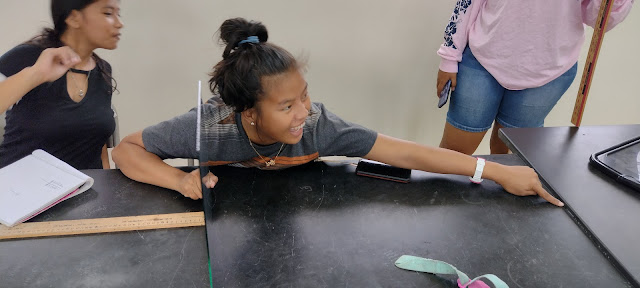Optics including index of reflection and refraction
Monday I dragged out the DVD player - unused in three years - and showed Bill Nye's Light and Optics video.
As the video ran, I made notes from the video on the board
Including the greenhouse effect that Bill Nye covers during the video.
Wednesday I did demonstrations with the laser and objects filled with water to demonstrate refraction and total internal reflection.
While Desmos allows the reflection table and graph to be in the object-image order and the refraction table and graph to be in the image-object order, my experiment with this sequence today would prove confusing, especially in the 11:00 class. The object-image order is the mathematically appropriate independent-dependent variable order, but this does not then produce the index of refraction for water. Of note is that both the 8:00 and 11:00 sections opted for equations of the form y = mx + b. No one chose to take the y-intercept to be zero. Neither section postulated an index of reflection slope of one, but then I intentionally did not display a line on the reflection graph. I did have the word slope in the introduction, but perhaps that should be omitted. I often use lab eleven to introduce the idea that dimensionless constants ought to be near one according to those who argue from a beauty perspective. This leads into the fine tuning issue in cosmology - the Goldilocks universe we find ourselves in. But in retrospect this seems to only add to the complexity of this lab and the potential for confusion. I would recommend running the reflection table back in the image/object order. This would simplify the graph axis labels as well.
Richard works with the mirror
Darla and Renay agree on the image location while Adelina holds the mirror tile
The doll and doll image can be seen in this setup
No student argued that the image of the meter stick proved that the doll image was at an equal distance to the doll object. The image doesn't actually prove this: the mirror could theoretically distort the length. But a geometric optics argument could be made that a plane mirror does not distort the length.
Physical science lab includes background music - the environment counts
Board at the end of the 8:00 section
A few additional notes
Donnalynn, Leipolanda, and Blossom work out the logistics of making measurments
The group above appears to have done the laboratory according to specification, yet their index of reflection was 1.33 and their index of refraction was 3.48.
Bethlyanne measures while Rose Anne records data
Saya measuring while Johnston records
Rose Anne working on estimating the apparent depth
Saya making an apparent depth measurement
Johnston recorded data
Mellyann hold the mirror while Malika points to the image location
Malika in the looking glass
Leipolanda reaches the limit of her ability to locate the image
Board overview
Data from 8:00 and 11:00
Additional notes include a sketch of the laboratory sequencing. In the fine print is that the 3.48 index of refraction for water represents a 161% error. The group did not opt to remeasure.



























Comments
Post a Comment